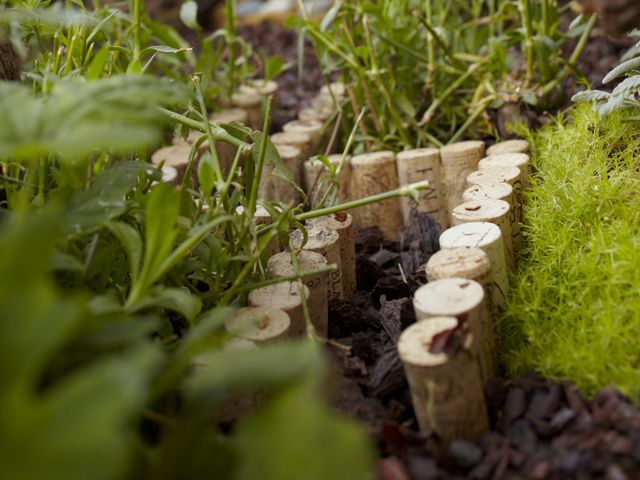Repurpose the wine corks you’ve been saving for use in your garden.
Don’t throw away your wine corks—use them in your garden! Whether you have an entire collectionreserved for that art projectYou keep postponing, or maybe just one or two, corks can improve your outdoor area immediately with many smart methods. With only a few tools and materials, here’s how to reuse wine corks for attractive and useful applications in your garden.
1. Plant Markers
Turn wine corks into simple DIY plant markersUsing only a permanent marker and wooden skewers. Write the name of the plant on the side of the cork with your marker, or you can add some style by using a woodburning pen if you have one. Next, insert the sharp end of a skewer into one end of your cork, based on whether you want the word to be read from the top going downward or starting at the bottom of the cork.
Your new plant labels will bring a cozy, handcrafted touch to vegetable patches, herb areas, and potted gardens. The cork material is durable enough to withstand weather conditions, ensuring it lasts through at least one growing season.
2. Pot Feet
Pots and planters allow for better drainage when elevated slightly above a flat surface. You can purchase pot feet or plant stands for this purpose, but wine corks provide an easy alternative. Slice several corks in half lengthwise, then attach them to the bottom of your pots before adding soil.
Ensure the corks are cut so that each piece is the same height, allowing the pot to remain level. The additional space enables water to drain away from the pot’s base, which is beneficial.avoid root rotin addition to staining on patios or decks. You can also place the pot in a saucer, allowing the cork feet to keep the bottom of the pot from being submerged in water, which helps prevent the soil from becoming overly moist.
3. Mulch for Pots
Natural corks (as compared to synthetic alternatives) are crafted from the bark of cork oak trees, and similar to the bark of other trees, you canuse it as mulch. Shred your leftover wine corks into tiny pieces, and then spread them around the bottom of your plants as a homemade mulch. Since cork is light and floats, it’s ideal to use this type of mulch in potted gardens where the edge of the container will prevent them from being washed away during heavy rain. Similar to othertypes of organic mulch, your cork mulch will assist in retaining moisture, prevent weeds, and ultimately decompose into the soil.
4. Create a Garden Kneeling Mat
If you possess a significant number of wine corks, or if you have friends who enjoy drinking wine and want to help out, you can create a basic kneeling pad for gardening purposes. Use hot glue to attach the corks next to each other in a rectangular pattern. Try to achieve a total surface size that is between 21 to 36 inches in length and 14 to 18 inches in width. Apply the cork rectangle on top of a cheap outdoor waterproof mat to provide additional stability. Cut the mat to fit the corks if needed. The corks will offer comfort for your knees during your next gardening session.you need to weed or plant.

5. Fairy Garden Accessories
Let your creativity run wild to reuse wine corks in a variety of imaginative ways forfairy gardensFor instance, you can position the corks upright to act as borders for a small garden path, as illustrated above. Alternatively, you can cut them into slices that can be used as stepping stones. Cut your corks in half along their length and use them to make cute, log-shaped steps. Attach four toothpick legs to one of these half-cork pieces, and you’ll have a charming garden bench ideal for a fairy setting.
6. Topper for Stakes
Bamboo sticks or various kinds of supportsmake sturdy supportsFor tall vegetables and flowers. However, they can pose a risk when you’re near them. Cap the ends with wine corks to reduce harm if one accidentally hits you. Additionally, you can color the corks with vibrant hues to increase visibility of the stake ends.
7. Compost Your Corks
If you’re not in the mood for crafting but don’t want to throw away your wine corks, justAdd them to your compost container. Chop them into small pieces to speed up the decomposition process. They are considered a “brown” material in your compost, which should be layered with “green” materials for thethe composting process works best.
Read the original story onBetter Homes & Gardens







